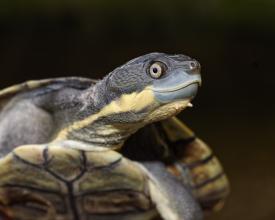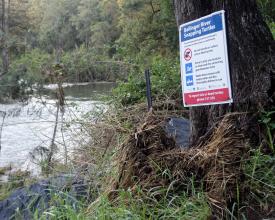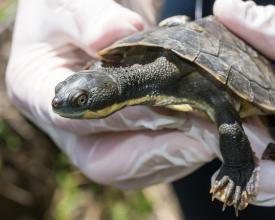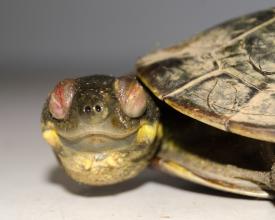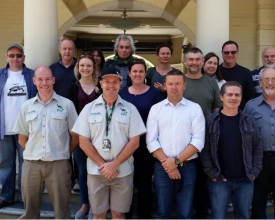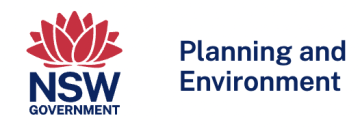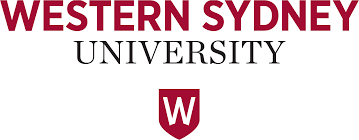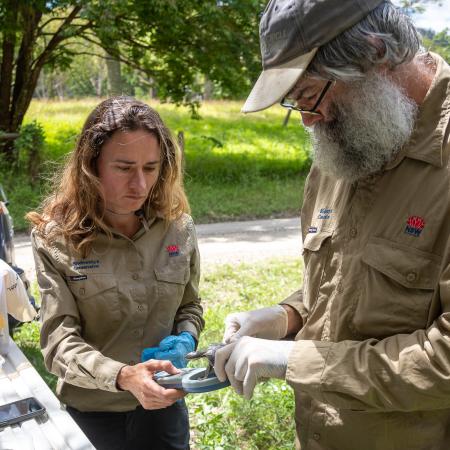
Bellinger River Virus Disease Response
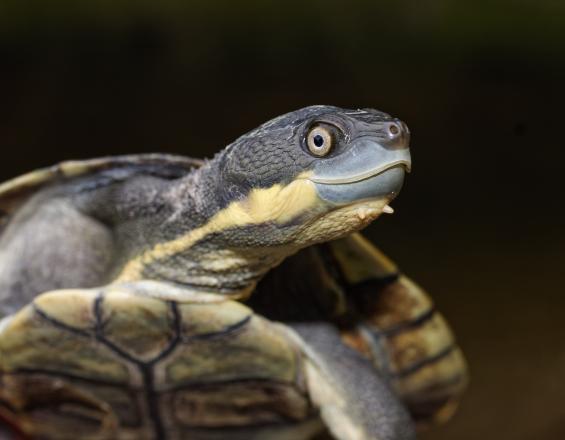
In 2015 a mass mortality event struck the highly range restricted Bellinger River Snapping Turtle (Myuchelys georgesi), wiping out 90% of the species in under six weeks. The initial emergency response included site examinations, removal of dead and sick animals, and a water quality investigation. Bellinger River Virus (previously unknown to science) was eventually identified as the causative agent. To better understand the circumstances behind this mass mortality event, a One Health approach was taken addressing how the animals, causative agent, and surrounding environment interacted with each another. A facilitated multi-stakeholder conservation planning workshop was held incorporating the IUCN SSC/OIE’s Wildlife Disease Risk Analysis process (Jakob-Hoff et al, 2014). This ensured all potential contributing factors associated with the Bellinger River Virus outbreak were reflected in immediate and long-term priorities and on-ground recovery actions.
Context
Challenges addressed
The main challenges facing conservation planners following the mortality event were the uncertainty surrounding cause of death and the species’ small population size. Bellinger River Snapping Turtles are endemic to an estimated 80km stretch of the Bellinger River. Prior to 2015, the wild population comprised roughly 4,000 individuals, leaving the species vulnerable to extinction following the sizable mortality event. Additionally, the Bellinger River Virus had a disproportionate impact on the adult turtle population. Due to their reproductive biology, this sharply diminished the species’ ability to repopulate. The cause of death was not known during the initial stages of the emergency response, leading to a broad investigation that eventually identified the previously unknown Bellinger River Virus.
Location
Process
Summary of the process
The One Plan Approach is built upon the concept of collaborative partnerships – only through open and honest collaboration can the previously siloed sectors of ex situ and in situ population management effectively come together. The full response, including the site examination, status review, disease risk analysis, captive breeding program, and reintroduction program, was spearheaded by government authorities, but was supported by a diverse body of stakeholders. The partnerships developed were rooted in a shared desire to protect this unique and threatened species and made possible an enduring level of cooperation and information sharing.
Building Blocks
One Plan Approach
Developed by IUCN CPSG, the One Plan Approach (OPA) is a method of species management that develops a conservation plan with input from all stakeholders involved with both in situ and ex situ populations of the species. This brings together conservation managers: field biologists, researchers and wildlife managers who monitor wild populations, and zoo and aquarium personnel who manage various ex situ populations. Experts, researchers, decision-makers, and stakeholder representatives were brought together for a workshop, hosted by neutral CPSG facilitators, to carry out a species status review, a disease risk analysis, and develop a conservation management plan.
Enabling factors
The One Plan Approach (OPA) is a coordinated conservation planning process that seeks consensus decisions by multiple stakeholders in the best interests of the threatened species. The most relevant information regarding the species and disease risks was gathered and shared prior to the workshop. By establishing a mutually respectful, collaborative environment CPSG facilitators enabled workshop participants to work effectively to develop integrated short- and long-term plans for the species.
Lesson learned
The conservation planning principles and steps developed by the CPSG over 40 years guided a successful One Plan Approach to conservation of the Bellinger River Snapping Turtle following the 2015 mass mortality event. By approaching the challenge through a systems-based One Health lens, (encompassing interactions between animal, human, and environmental health), a plan that captured and developed mitigating strategies for the broad range of threats facing the turtles was developed. The inclusion of diverse and relevant stakeholders from the beginning of the process ensured the plan was based on the most current knowledge and widely accepted and implemented.
Collaborative Partnerships
The process of responding to the mass mortality event, from the initial discovery of turtle carcasses through to eventual reintroduction of captive bred juveniles to the wild, was done through collaboration between government authorities, researchers, in situ and ex situ conservation managers, and local people who were personally invested in the turtles’ wellbeing. The communities living around the Bellinger River derive pride from the species endemic to their corner of the world, and their concern and participation as citizen scientists played a large role in raising awareness and ensuring resources were directed to the turtles. The government authorities were the central facilitators of the response, seeking out expertise across many sectors to ensure a comprehensive analysis was done.
Enabling factors
The CPSG principle of neutral facilitation creates a collaborative and open-minded space to address conservation challenges. While the stakeholders involved in the response and workshop were from different sectors with their own motivations, the unifying end goal of developing a conservation plan that address all the risks the Bellinger River Snapping Turtle was facing was able to bridge those differences.
Lesson learned
Conservation plans are often limited by the information on which they are based. By engaging with a larger scope of stakeholders, diverse and previously unconsidered perspectives can be captured in the planning process. This ensures all risks are considered, generating a more comprehensive and well-rounded management plan and a comprehensive foundation for long-term survival in the wild.
Impacts
A multi-agency, comprehensive response to the mass mortality event prevented the small, endemic population of Bellinger River Snapping Turtle from going extinct. A captive breeding program was established early in the response through Taronga Zoo, and over 80 juvenile turtles have since been successfully released back into the river through a coordinated recovery program. Population reinforcement, together with multiple complementary lines of research and on-ground action, have been essential components of the conservation plan developed with facilitation by the IUCN-SSC Conservation Planning Specialist Group (CPSG). The collaborative, multi-stakeholder approach to conservation planning resulted in a consensus-based management plan that included disease mitigation measures, steps to address threats facing the river ecosystem, and ways to engage the local community in on-going monitoring. Although the disease event changed the status of the species to critically endangered, there is now hope that, with ongoing management, the Bellinger River Snapping Turtle will persist in the wild.
Beneficiaries
- Bellinger River Turtle
- Greater river ecosystem
- Conservation planners – government and researchers
- Local communities surrounding the Bellinger River
Sustainable Development Goals
Story

In 2015, reports of dead and dying turtles washing onto the banks of the Bellinger River sent shock waves through conservation scientists, wildlife managers, veterinarians, and the close-knit Bellingen community. As more and more turtles were reported dead and early attempts to treat sick animals proved ineffective, the scale of the disaster emerged; a mass mortality event with an unknown cause, rapidly wiping out the small, endemic population of the Bellinger River Snapping Turtle. Early investigations ruled out pollution and toxicity as the cause; the emergency rescue quickly adapted to wildlife disease as the most likely driver. Conservation managers and scientists worked quickly with the incident control team and the local community to identify upper reaches of the river they hoped would contain healthy animals. An emergency capture was planned, with the aim of establishing an insurance population. Within weeks of the first reports of sick turtles, the team were urgently retrieving animals. There was intense community scrutiny and expectation; a need to know and be provided with explanations. The Bellinger River is at the heart of the Bellingen community, and the plight of the turtle concerned many. Collecting a healthy insurance population had to balance urgency and uncertainty. Strict biosecurity guidelines were put in place for the capture and transportation of animals outside the catchment, and a quarantine facility was built at Western Sydney University. 17 healthy turtles were recovered from the upper reaches of the river before the disease advanced. These animals now form the basis of a captive breeding population, with over 80 offspring released into the Bellinger River since 2018. Today, the Bellinger River Snapping Turtle program is a well-established conservation recovery program owing its success to the dedication and collaboration of a broad range of people, overseen by an expert reference group with numerous others providing local knowledge and practical expertise. Volunteers assist with biannual surveys and water quality monitoring and >50 private landowners allow access to river habitat. The government team leading the program believe it is a privilege to work on the recovery of the turtle and are thankful to all those contributing to the shared goal of recovering the species in the wild. Strong collaborations and enduring partnerships, established during the emergency response and early conservation planning, remain a key strength in the recovery of this turtle.
